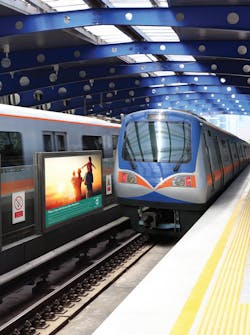Bringing it All Together – How Modern Rail Hubs Incorporate Retail and Digital Signage to Recover Costs
The public transportation sector is facing many new challenges as a result of population growth, the trend toward urbanization, and an increase in the number of people who are reducing their reliance on cars. With future needs in mind, major rail hubs around the world are undergoing significant renovations, and new rail hubs are being planned and designed.
Because the construction and operation of these new hubs can run into the billions of dollars, railways are seeking ways to recoup their investments and ensure financial sustainability by developing comprehensive plans for their hubs. They aim to offer passengers, local residents and visitors a range of mixed-use facilities that will result in a big win for everyone: rail companies, passengers, local residents, visitors and taxpayers.
Mixed-use facilities
Rail stations have always been a crucial part of rail operations, but modern rail hubs will be much more than just the buildings that passengers rush through to catch trains. These new stations will enhance the transportation experience by providing retail, dining and other amenities.
The impact of a new or refurbished rail hub will extend beyond the station itself. Real estate developers have already found profits in siting office, retail, residential and other projects close to rail stations, and railways hope to match these successes.
The rising need for public transportation has led to cities around the world to refurbish existing rail hubs and plan new rail hubs, not only to improve transportation but also to provide passenger, community members and visitors with a wide range of services. In the United States, Washington, D.C. (Union Station), Philadelphia (30th Street Station) and New York (Penn Station) are among the cities that have renovated or are renovating existing rail hubs.
The marriage of rails and retail
The renovation of these rail hubs is particularly good news for retailers. Brick-and-mortar retail has been suffering over the past decade, due in part to competition from internet giant Amazon and other online retailers. Retail spaces located in rail hubs present retailers golden opportunities to attract and retain customers.
Transportation centers are a great fit for retail because so many transit customers pass through them every day. Likewise, for railways, whether privately owned or public, offering attractive retail space in their hubs provides a viable way to recover the costs of their operations.
The marriage of rails and retail is nothing new. Private transit companies in Japan and Hong Kong have successfully boosted their bottom lines by creating mixed-use transportation hubs that nimbly combine transportation services with retail and community development. Tokyo’s privately owned rail lines have turned riders into customers (and customers into riders) by offering a wide range of shopping and dining options in or near their rail stations. For example, the Tokyu Corporation’s Tokyu Department Store sits atop Tokyo’s Shibuya train station, which the private rail company operates jointly with three other transportation companies. Likewise, Hong Kong’s MTR Corporation, which operates the city’s mass transit system, has profited from developing properties next to its stations.
New rail hubs are incorporating these lessons. For example, New York City’s World Trade Center Transportation Hub opened in 2016. It serves more than 250,000 daily commuters and millions of visitors annually. The hub’s dramatic Oculus hall has 78,000 square feet of retail and dining space. Retail tenants in the Oculus hall include Apple, H&M, Sephora and Tumi. The hub will eventually link to 290,000 additional square feet of adjoining retail and dining space as additional World Trade Center buildings open over the next few years.
The role of digital displays in rail hubs
Because of its many benefits, digital signage has become a common sight in rail stations. Large format displays provide passengers up-to-the-minute information on departing tracks, delays and cancellations. Digital kiosks smooth wayfinding, ticketing and check-in.
Digital displays are also well-suited for retailers in rail hubs. By using digital signage to create a captivating, customizable and eye-catching shopping experience, retailers can drive sales and boost revenue streams. Exterior signage grabs the attention of passengers and other people passing their stores, inviting them inside to browse the retailer’s offerings.
Interior signage can present ads and other information to engage shoppers and increase sales. Digital displays show off entire product lines, and displays that feature inactive touch screens allow customers to explore product features and such options as size or color choice.
Digital displays can also help rail hubs integrate their operations into Smart City initiatives to connect with people and move them through cities more efficiently. At rail hubs, digital displays can provide real-time information on traffic and local public transportation options, easing passengers’ trips to their ultimate destinations. In addition to offering passengers a better experience, these displays can deliver highly relevant ads. For example, during the morning hours a cafe in the rail station can promote its breakfast specials.
Hubs of the future
As transportation needs evolve, a modern rail hub will soon be a necessity for any forward-looking city. Next-generation rail stations will serve as urban hubs that integrate transportation, commercial, residential and other uses. These new hubs will provide sustainable income for the railways and retailers, as well as support smart city initiatives and economic growth in adjoining neighborhoods.
Paul Redding is a business development manager with NEC Corp. He can be reached via LinkedIn at linkedin.com/in/paredding.


